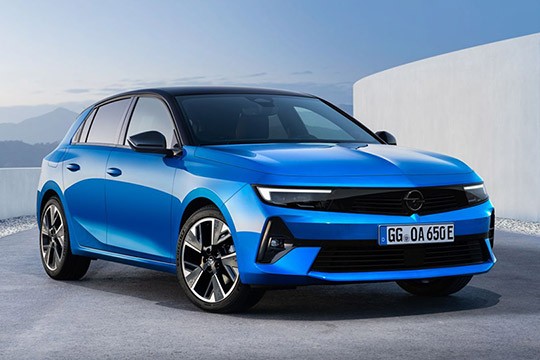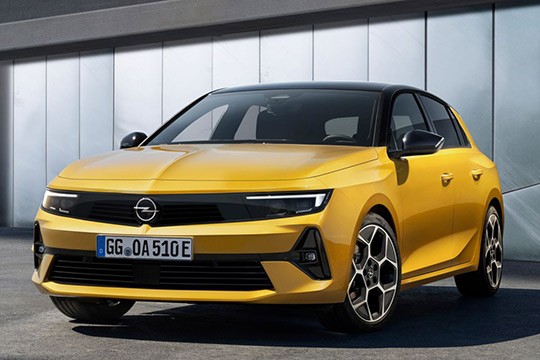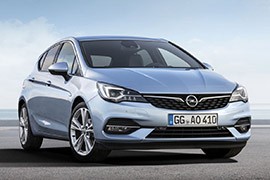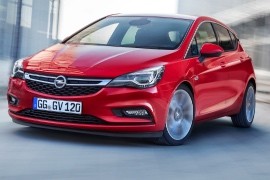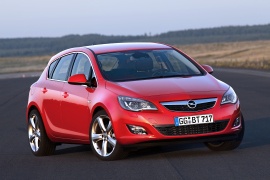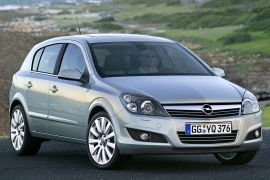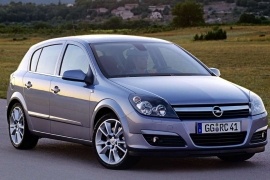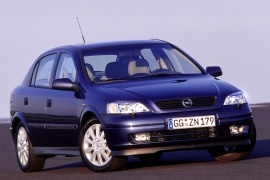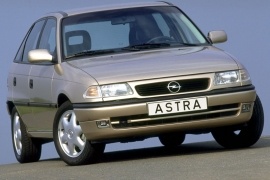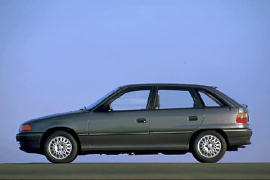OPEL Astra 5 Doors Models/Series Timeline, Specifications & Photos
First production year: 1991
Engines: Electric, Diesel, Gasoline, Natural gas
Body style: Hatchback
In 2021, Opel opened the sixth chapter of the Astra's book, but, unlike its predecessors, it didn't share its platform with other GM products since it had already joined the Stellantis group together with its new owners, PSA (Peugeot-Citroen).
Since it used the EMP2 platform used by Peugeot for the 308 lineup, which was available as an electric version, it was only a matter of time before the Astra could offer an electron-powered version. That came in late 2022 in the form of Astra Electric, which was available in two bodywork versions: a five-door hatchback and a station wagon. The latter was traditionally named Sports Tourer.
The all-electric version sported a similar shape as the rest of the Astra range. It shared a slightly modified version of the new Opel Vizor front fascia, albeit it didn't have the slats needed to cool the engine since it didn't have an IAC. The car's profile revealed an angular shape with an up-kick for the C-pillar, with the A- and B-pillars blacked out. At the back, the lower bumper was slightly different since it didn't have to conceal an exhaust tip.
Inside, the carmaker installed a fully digital Pure Panel with two large 10-inch widescreen displays. The dashboard's minimalist design and the center console's clean lines were part of Opel's design philosophy. The 2023 Astra Electric featured a pair of ergonomic Active Sports seats, optionally wrapped in Alcantara, which promised a comfortable ride and good side support for their occupants. In the back, a split-folding bench provided room for three adults.
Powered by a 115 kW (154 hp) motor, the compact hatchback could drive for 416 km (258.5 miles) on a full charge thanks to its floor-mounted 54 kWh lithium-ion battery pack.
Opel opened a new chapter in the Astra book with the sixth generation of its compact hatchback in 2021. This time, the car came under new management after Opel joined Stellantis together with its new owners, PSA (Peugeot-Citroen).
Gone were the days when GM was the owner of the Opel-Vauxhall brand, and the new management decided to make some changes to cut costs. Thus, the older Astra platform was replaced by Peugeot's EMP2 platform carried over from Peugeot 308. Also, Astra's sixth-generation was the first to feature a plug-in hybrid version.
The 2021 Astra shows the new Opel Vizor front fascia, first seen on the Mokka, as the central exterior design element. It follows the Opel Compass idea where the vertical and horizontal axes intersect with the Opel Blitz badge in the middle. On the lower side of the bumper, the carmaker placed a broad grille flanked on the sides by a pair of scoops for the fog lights. The car's profile revealed an angular shape with an up-kick for the C-pillar, with the A- and B-pillars blacked out. At the back, the extended downwards roof-spoiler resembled the one installed on the Astra GSI (F-Generation). In addition, the car featured LED headlights, taillights, and fog lamps, depending on the trim level and options.
Inside, the carmaker installed a digital cockpit with a fully-glazed option. The minimalist design of the dashboard and the clean lines of the center console were part of Opel's design philosophy. As the fifth generation, the 2021 Astra featured a pair of AGR-approved seats that offered a comfortable ride and good support for the occupants. In the back, a split-folding bench provided room for three adults.
The new Astra generation might be the last one made without PSA involvement. The new Opel Astra is, actually, a direct competitor for its brothers, the Citroen C4 and Peugeot 308 from PSA.
The main focus was to lower the fuel consumption and the result is really good. They improved the figures a lot, lowering the consumption with an average 19% compared with the previous generation.
Even though the look is quite similar to its predecessor, the differences are quite extensive. Firstly, the aerodynamic factor is the lowest on the market, especially for the station wagon body variant. The value for the hatchback's Cx is 0.26, which is the same value as the former world-record held by the Opel Calibra back in the 90s, but that was a sporty coupe. The new value is a world-record for a hatchback. The station wagon's (called Astra Sports Tourer) Cx is even better, at 0.25.
The technical platform was developed by Opel and carries on one of the best half-independent rear suspensions from the market, a Watt's linkeage. For the engine compartment, Opel installed two 3-cylinder gasoline units, turbocharged, of 1.2 and 1.4-liters. They are offering 110 hp and 145 hp respectively. Two turbodiesels are offered, variations of the same 1.5-liter engine, with 105 hp and 122 hp, respectively.
For the transmission, Opel offers a 6-speed manual and a CVT with seven pre-set gears, which is said to be even smoother then any ordinary automatic gearbox.
For the interior, LCD-technology made its way to the instrument cluster and it is also on the infotainment display. Just like the previous generation, the refreshed Astra supports Android Auto and Apple CarPlay.
The seventh generation of the Opel Astra was introduced in 2015 at the Frankfurt Motor Show. It featured a newer, sharper design. It was equipped with the latest technologies available at the moment.
The Astra was one of the best-known names in Europe, with over 24 million units sold from its previous generations, including the Kadett. It was a huge success due to its very good price/money factor.
The Astra K was shorter than its predecessor. Its exterior design was inspired by the 2013 Monza concept-car. The Opel badge in the center of the chrome bar on the grill and the characteristic ‘blade’ raising towards the rear make the new Astra immediately recognizable as a member of the Opel family. A novelty for its car-segment was the full LED matrix headlights, which were offered as an option.
The Astra K featured a shorter wheelbase than the one on the Astra J but it offered 35 mm (1.4”) more legroom for the rear seat occupants. The trunk was decent, offering 371 liters (13.1 cu-ft) of space, that could have been extended by folding the rear seats. The infotainment unit was offered as an option, but it could feature an eight-inch touchscreen on the center console.
Mechanically and structurally, the 2015 Opel Astra was 200 kg (441 lbs) lighter than the Astra J. It also was stiffer and came with a revised suspension and steering as well as the latest generation engines in the automaker's stable.
OPEL Astra 5 Doors 1.0L ECOTEC 5MT (105 HP)
OPEL Astra 5 Doors 1.0L ECOTEC Start/Stop 5AT (105 HP)
OPEL Astra 5 Doors 1.4L 5MT (100 HP)
OPEL Astra 5 Doors 1.4L ECOTEC 6MT (125 HP)
OPEL Astra 5 Doors 1.4L ECOTEC 6MT (150 HP)
OPEL Astra 5 Doors 1.4L ECOTEC Start/Stop 6AT (150 HP)
OPEL Astra 5 Doors 1.4L ECOTEC Start/Stop 6MT (125 HP)
OPEL Astra 5 Doors 1.4L ECOTEC Start/Stop 6MT (150 HP)
The fourth generation of the Opel Astra, or Astra J, was unveiled at the 2009 Frankfurt Motor Show. It competed successfully in the most competitive compact segment.
The Astra didn't have the hi-tech look of some of its competitors or the low price of the others. It didn't have the high quality of the interior either. But the overall price/value package was among the best in its class. That is why it became one of the most known cars in Europe.
The styling was inspired by the Insignia, with curved headlights on their lower part. The large and narrow grille was accompanied by another grille in the bumper. Both did the same job, of cooling the engine and the AC compressor. From the side, a corner-window was installed in front of the rearview mirrors.
Inside, the dashboard looked high-tech for the time it came on the market. It featured four round dials on the instrument cluster, with the engine temperature and fuel level in the upper-middle sector. Between the large speedometer and tachometer, there was an LCD screen. The seats were awarded by a German institute for comfort and that said a lot about the car.
Under the hood, there were engines for everyone. From a naturally aspirated 1.4-liter unit to high-tech turbocharged diesel and gasoline options. The Astra had something for every pocket and every taste. It featured manual and automatic transmissions. And, due to its unique Watt rear suspension, it offered one of the best compromises for a rear semi-independent suspension.
OPEL Astra 5 Doors 1.3L CDTI ecoFLEX 6MT FWD (95 HP)
OPEL Astra 5 Doors 1.6L CDTI 6MT FWD (110 HP)
OPEL Astra 5 Doors 1.6L CDTI 6MT FWD (136 HP)
OPEL Astra 5 Doors 1.7L CDTI 6MT FWD (110 HP)
OPEL Astra 5 Doors 1.7L CDTI 6MT FWD (125 HP)
OPEL Astra 5 Doors 1.7L CDTI 6MT FWD (130 HP)
OPEL Astra 5 Doors 2.0L CDTI 6AT FWD (165 HP)
OPEL Astra 5 Doors 2.0L CDTI 6MT FWD (160 HP)
OPEL Astra 5 Doors 1.4L EcoFLEX 5MT FWD (100 HP)
OPEL Astra 5 Doors 1.4L EcoFLEX 5MT FWD (87 HP)
OPEL Astra 5 Doors 1.4L Ecotec Turbo 6AT FWD (140 HP)
OPEL Astra 5 Doors 1.4L Ecotec Turbo 6MT (140 HP)
OPEL Astra 5 Doors 1.4L Ecotec Turbo 6MT FWD (120 HP)
OPEL Astra 5 Doors 1.6L Ecotec 5MT FWD (115 HP)
OPEL Astra 5 Doors 1.6L Ecotec 6AT FWD (115 HP)
OPEL Astra 5 Doors 1.6L Ecotec Turbo 6AT FWD (170 HP)
After three years on the market and more than 1.3-million units sold, Opel decided to upgrade the Astra lineup, leading to a new five-door hatchback version for this popular European vehicle.
While in the. U.S. Saturn tried to sell the European compact-sized hatchback and failed miserably. In Europe, the Astra was already an established nameplate. But like on American soil, Opel counted on fleet owners to give them this product.
There were no noteworthy differences between the 2004 and the 2007 models from a distance. Still, a trained eye could have seen the new headlights. Moreover, Opel offered an adaptive headlight system as an option, which was not a regular feature for the compact segment. At the front, the new bumper sported new scoops for the foglights, while the headlights featured a chromed look.
Inside, Opel kept the same acclaimed bucket seats that were built for zero-gravity, thus enhancing the comfort aboard. Access to the rear bench was good, and there was decent legroom for grown-ups. Even though the bench was wide enough for three occupants, they would've to rub their elbows so two people would better suit.
Under the hood, the German carmaker bet on enhanced turbodiesel and gasoline engines. Still, unlike its three-door sibling, it was stripped from the OPC version that pumped out 240 ponies. But it shined in the fuel efficiency contest with the 1.3-liter, Fiat-sourced turbodiesel. Also, the most powerful version for the five-doors Astra was a 150 PS (148 hp) turbodiesel.
Opel introduced the third generation of its compact lineup, Astra, in 2004 as a five-door hatchback, and, later on, it completed the range with other body versions.
It was a major revamp for the German brand when compared to its predecessor. It was technologically advanced and offered even an adaptive suspension, which was unusual for a budget compact vehicle.
At the front, the design team installed swept-back headlights with a two-slat grille and a chromed horizontal bar. Its bumper was split in three, with a center grille flanked by two scoops for fog lights offered as an option. Unlike its predecessor, the 2004 model, known as Astra H, featured body-colored bumpers for the entire range, regardless of the trim level. In the five-door version, the vehicle featured a wide C-pillar and an almost vertical tailgate.
Inside, Opel improved the material's quality and added more options on the list, including a navigation system. Even the base models featured a sound system. Depending on the engine version, the Astra H featured flat or sport bucket seats at the front, but the carmaker offered the same split-bench in the back, which increased the trunk size when folded from 312 liters (11 cu-ft) to 1265 liters (44.6 cu-ft), which was not exactly on top of its segment.
Under the hood, Opel offered the Astra five-doors with a choice of eleven engines, both gasoline, and turbo-diesel. It featured one of the best semi-independent rear suspensions in the compact segment.
OPEL Astra 5 Doors 1.3L CDTi 6AT FWD (90 HP)
OPEL Astra 5 Doors 1.3L CDTi 6MT FWD (90 HP)
OPEL Astra 5 Doors 1.7 CDTI 5MT FWD (80 HP)
OPEL Astra 5 Doors 1.7L CDTI 5MT FWD (100 HP)
OPEL Astra 5 Doors 1.9L CDTI 6AT FWD (120 HP)
OPEL Astra 5 Doors 1.9L CDTI 6MT FWD (100 HP)
OPEL Astra 5 Doors 1.4L 16V 5AT FWD (90 HP)
OPEL Astra 5 Doors 1.4L 16V 5MT FWD (90 HP)
OPEL Astra 5 Doors 1.6L 16V 5AT FWD (105 HP)
OPEL Astra 5 Doors 1.6L 16V 5MT FWD (105 HP)
OPEL Astra 5 Doors 1.8 16V 5MT FWD (140 HP)
OPEL Astra 5 Doors 1.8L 16V 4AT FWD (125 HP)
OPEL Astra 5 Doors 1.8L 16V 5AT FWD (140 HP)
OPEL Astra 5 Doors 1.8L 16V 5MT FWD (125 HP)
Opel introduced the second generation of the Astra in 1998, and right off the bat, it was available as a three and five-door affair, plus a station wagon.
The German brand was still under GM’s umbrella when it developed and produced the Astra. It was a very important car for the European compact-sized segment, and that’s why it was produced in various shapes until the third generation of this nameplate replaced it in 2009. The five-door version played in the highly competitive market segment against the Volkswagen Golf, the Renault Megane, and the newly introduced Ford Focus. GM used the same blueprints to create the Chevrolet Astra for the Brazilian market and the Holden Astra for Australia and New Zealand.
By combining the rounded body panels with a few sharp lines, Opel’s designer created a best-of-both-worlds shape for the vehicle, combining the elements from the bio-design era with those from the new-edge styling. As a result, the Astra featured horizontal headlights with a clear but arched cut on their upper side and a straight lower line. These flanked the hood, which incorporated the main grille. On the lower bumper, the automaker added an apron that hosted a second air intake and, as an option, a set of fog lamps.
From its profile, the short overhang and low nose were elegantly followed by a raked windshield and a well-proportioned greenhouse compared to the car’s overall size. The body-colored door mirrors were highly appreciated by customers, but the black door handles for the entire range were clear signs of cost-cutting measures. The slightly flared wheel arches didn’t provide the image of a sporty vehicle, but they matched the car’s overall design. At the back, the raked-forward tailgate was flanked by thick C-pillars and integrated a short deck with a window wiper.
Inside, it was a form-follow-function design layout with everything centered around the driver. The bucket seats provided low bolstered areas for the front occupants, while in the back, a split-folding (60/40) bench seat could host three adults. Fronting the driver was a clean-designed instrument panel with a large tachometer and a speedometer in the center section, which were flanked by the fuel gauge on the right and the coolant temperature on the left. Depending on the options and grade, customers could get either a simple steering wheel or one with buttons on it for the sound system and the onboard computer. On the center stack, Opel installed a simple stereo cassette player for the lower grades while a CD player was available.
Under the hood, Opel installed a wide choice of engines ranging between 1.2- and 2.2-liter, with gasoline or diesel. Most versions were paired with five-speed manual transmissions, while a four-speed automatic was available for selected engines.
OPEL Astra 5 doors 1.2L 12V 5MT FWD (65 HP)
OPEL Astra 5 doors 1.4L 16V 5MT FWD (90 HP)
OPEL Astra 5 doors 1.6i 16V 4AT FWD (100 HP)
OPEL Astra 5 doors 1.6i 16V 5MT FWD (100 HP)
OPEL Astra 5 doors 1.6i 4AT FWD (75 HP)
OPEL Astra 5 doors 1.6i 4AT FWD (85 HP)
OPEL Astra 5 doors 1.6i 5MT FWD (75 HP)
OPEL Astra 5 doors 1.6i 5MT FWD (85 HP)
OPEL Astra 5 doors 1.8i 16V 4AT FWD (115 HP)
OPEL Astra 5 doors 1.8i 16V 4AT FWD (125 HP)
OPEL Astra 5 doors 1.8i 16V 5MT FWD (115 HP)
OPEL Astra 5 doors 1.8i 16V 5MT FWD (125 HP)
OPEL Astra 5 doors 2.0i 16V 4AT FWD (136 HP)
OPEL Astra 5 doors 2.0i 16V 5MT FWD (136 HP)
After three years since the model's launch, Opel refreshed the first generation of the Astra in 1994, introducing new engines and new safety features.
Retiring the Kadett nameplate didn't seem like a good idea from the German carmaker. But soon, Opel proved that it was right. The new Astra was far from the initial Kadett concept. After 1980, the compact hatchback became famous for its sporty versions but still highly popular for families and loved by rental companies. In the five-door hatchback shape, the Astra was an excellent contender against the best-known German hatchback, VW Golf.
The facelifted version received a new front fascia with a redesigned grille that sported a reversed trapezoidal shape and the chromed Opel badge in the middle. Previously, the Astra featured a one-slat grille. The carmaker dropped the orange lenses for the turn signals favoring the clear-lens system, with orange bulbs inside to comply with the European legislation. At the back, the liftback version received smoked lenses instead of clear ones from the 1991 model.
Inside, the carmaker introduced a new dashboard, which included a passenger airbag. For the sound system, Opel offered an option for a CD player for the top trim levels, while the base version remained without any radio. The rear folding rear bench increased the trunk space from 360 liters (12.7 cu-ft) up to 1,200 liters (42.3 cu-ft).
Under the hood, the carmaker introduced a new Euro 2 compliant engine range. The base version featured a 1.4-liter that provided just 60 hp, but on the other end of the scale was a 2.0-liter, 150 hp. The Astra featured front disc brakes at the front and drums in the rear or all-around discs, depending on the engine version.
OPEL Astra 5 Doors 1.4i 5MT FWD (60 HP)
OPEL Astra 5 Doors 1.6i 16V 4AT FWD (100 HP)
OPEL Astra 5 Doors 1.6i 16V 5MT FWD (100 HP)
OPEL Astra 5 Doors 1.6i 4AT FWD (71 HP)
OPEL Astra 5 Doors 1.6i 4AT FWD (75 HP)
OPEL Astra 5 Doors 1.6i 5MT FWD (71 HP)
OPEL Astra 5 Doors 1.6i 5MT FWD (75 HP)
OPEL Astra 5 Doors 1.8i 16V 4AT FWD (115 HP)
OPEL Astra 5 Doors 1.8i 16V 5MT FWD (115 HP)
OPEL Astra 5 Doors 2.0i 16V 4AT (136 HP)
Opel decided to retire the Kadett nameplate from its lineup and made a bold move when introducing the first generation of the Astra in 1991.
For some, it was a shock, but later on, the carmaker proved it was the right thing to do, and the Astra had risen from the Kadett ashes. It was a new design concept and a new idea. Opel addressed the car not only to younger generations but to older people as well. Before that, it was hard to see a retired couple into a Kadett (cadet – young soldier).
The Astra featured a short front fascia with narrow headlights and grille, crossed by a thin slat. From its sides, the design team kept the straight line theme for the rear wheel-arch from the Kadett but enlarged, which started from the rear doors. The Astra F featured a wide rear glass area between the rear doors and the D-pillars.
Inside, Opel placed its bets on a simple, functional interior centered around the driver. For that, it installed a tilted center stack, with easy-to-reach climate control buttons on the lower side and the stereo cassette above it. In the instrument panel, the carmaker placed the speedometer in the middle, flanked on the sides by the tachometer and a common area for the fuel and coolant temperature gauges. Opel designed new seats for the Astra, with no bolstering on the sides. Despite its short wheelbase, the car was very roomy inside and could accommodate up to five people.
Under the hood, Opel installed seven gasoline and two oil burners. The diesel versions were supplied by Isuzu and were offered with or without a turbocharger.
OPEL Astra 5 Doors 1.4L 5MT FWD (60 HP)
OPEL Astra 5 Doors 1.4L iS 4AT FWD (82 HP)
OPEL Astra 5 Doors 1.4L iS 5MT FWD (82 HP)
OPEL Astra 5 Doors 1.6 iS 4AT FWD (100 HP)
OPEL Astra 5 Doors 1.6 iS 5MT FWD (100 HP)
OPEL Astra 5 Doors 1.6L 4AT FWD (71 HP)
OPEL Astra 5 Doors 1.6L 5MT FWD (71 HP)
OPEL Astra 5 Doors 1.6L 5MT FWD (75 HP)
OPEL Astra 5 Doors 1.8L 16v 5MT FWD (125 HP)
OPEL Astra 5 Doors 1.8L 4AT FWD (90 HP)
